Premium Feed Miller with Mixer: Efficient Animal Feed Production
Sep . 10, 2025 08:40 Back to list
Premium Feed Miller with Mixer: Efficient Animal Feed Production
Optimizing Animal Feed Production with Advanced Feed Milling Technology
In the highly competitive animal agriculture sector, efficiency, consistency, and cost-effectiveness are paramount. Modern feed processing demands equipment that not only grinds and mixes raw materials effectively but also ensures optimal nutrient distribution and minimizes operational overheads. This article delves into the critical role of a robust feed miller with mixer in achieving these objectives. We will explore industry trends, technical specifications, application scenarios, and key advantages that empower B2B decision-makers to make informed procurement choices.
The integration of milling and mixing functions into a single, efficient unit, such as a vertical animal feed mixer with grinder, represents a significant leap forward in feed production technology. This design streamlines the entire process, from raw material preparation to final feed blending, resulting in superior product quality and enhanced operational throughput.
Current Industry Trends in Animal Feed Production
The animal feed industry is witnessing several transformative trends. There is an increasing demand for customized feed formulations tailored to specific animal types, growth stages, and dietary requirements. This necessitates highly adaptable and precise feed processing machinery. Furthermore, sustainability and energy efficiency are no longer optional but critical considerations. Manufacturers are continually seeking solutions that reduce energy consumption, minimize waste, and operate with a smaller environmental footprint. The rise of automation and smart technology integration is also influencing equipment design, enabling remote monitoring, predictive maintenance, and optimized operational control. These trends collectively emphasize the need for advanced feed mixer technologies that deliver superior performance, reliability, and economic value.
Market data suggests a Compound Annual Growth Rate (CAGR) of 4.3% for the global animal feed market from 2022 to 2027, driven by increasing meat and dairy consumption and a growing focus on animal nutrition. This growth underscores the escalating demand for efficient and robust feed processing equipment, including vertical feed mixers and integrated grinding solutions.
Detailed Process Flow: The Vertical Animal Feed Mixer with Grinder
The integrated operation of a feed miller with mixer, specifically a vertical animal feed mixer with grinder, ensures a seamless and efficient production cycle. This system is engineered for robustness, high performance, and longevity, adhering to stringent quality standards throughout its manufacturing process.
Product Materials and Manufacturing Excellence:
- Construction Materials: High-grade carbon steel (Q235/Q345) for structural components, often treated with anti-corrosion coatings. Critical wear parts, such as hammer mill screens and mixing augers, are typically made from hardened alloy steel or manganese steel for enhanced durability and abrasion resistance. Stainless steel (304/316L) is used for specific components that come into contact with sensitive ingredients or require superior hygiene.
- Manufacturing Processes:
- CNC Machining: Precision cutting and shaping of components ensuring tight tolerances and perfect fit. This is crucial for rotor balancing in grinders and auger alignment in mixers.
- Welding: Advanced robotic and manual welding techniques (e.g., TIG, MIG) for strong, durable joints, followed by non-destructive testing (NDT) to ensure structural integrity.
- Forging/Casting: For high-stress components like hammer mill hammers or specialized gears, providing superior mechanical properties.
- Surface Treatment: Powder coating, galvanizing, or specialized epoxy paints for corrosion resistance and aesthetic finish, extending service life in demanding environments.
- Testing Standards: Equipment undergoes rigorous testing aligned with ISO 9001 for quality management and CE standards for safety. Performance testing includes uniform mixing index (typically achieving a coefficient of variation
- Service Life: Designed for an operational service life of 10-15 years with proper maintenance, ensuring long-term return on investment.
Schematic Process Flow:
Reducing particle size for optimal digestion and mixing uniformity. Energy-saving design with optimized hammer configurations.
Homogeneous blending of all ingredients, including micro-components, ensuring nutrient consistency.
Target Industries & Advantages:
This integrated system is ideal for small to medium-scale feed mills, farms, and specialty feed producers across various sectors:
- Poultry & Livestock Farms: Producing customized feeds for chickens, pigs, cattle, and sheep.
- Aquaculture: Formulating precise diets for fish and shrimp, where ingredient integrity and consistency are critical.
- Pet Food Manufacturing: Creating specialized pet food blends.
In these scenarios, the vertical feed mixers for sale offer significant advantages:
- Energy Saving: Optimized motor and transmission systems reduce power consumption by up to 15% compared to separate grinding and mixing units.
- Uniformity & Consistency: The vertical design with internal augers ensures a Coefficient of Variation (CV) for mixing uniformity often below 5%, crucial for consistent nutrient delivery.
- Corrosion Resistance: Strategic use of treated materials and stainless steel in critical zones prolongs equipment life, especially when handling corrosive ingredients or operating in humid environments.
- Reduced Labor & Footprint: Integrated design minimizes the need for multiple operators and occupies a smaller physical footprint, making it ideal for operations with space constraints.
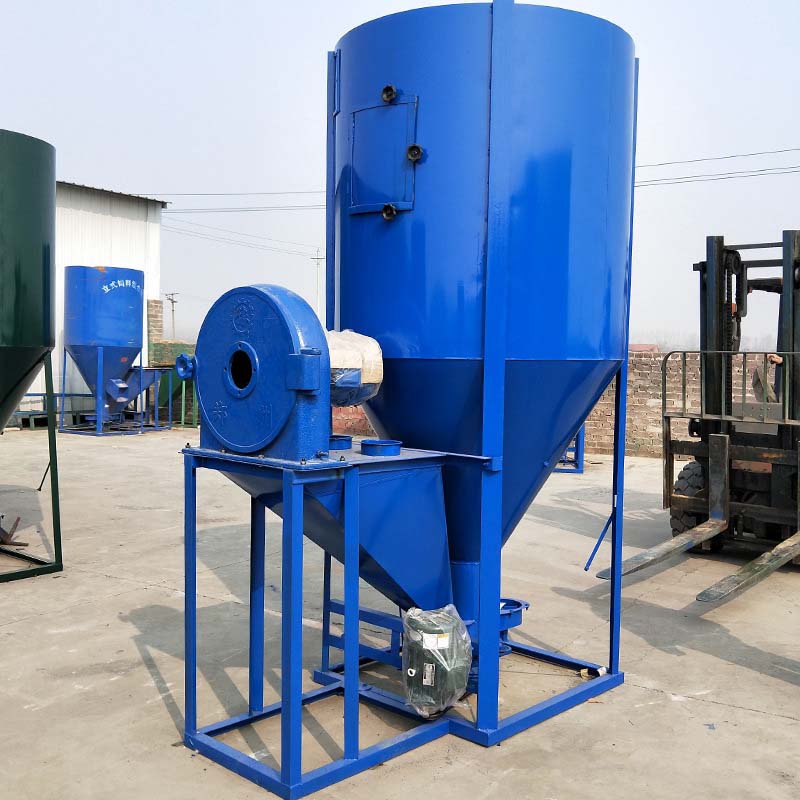
Technical Specifications of the Vertical Animal Feed Mixer with Grinder
Understanding the detailed technical specifications is crucial for evaluating the performance and suitability of an animal feed mixer for specific operational requirements. The following table provides typical parameters for a high-performance vertical animal feed mixer with an integrated grinder.
| Parameter | Description |
|---|---|
| Model Type | Integrated Vertical Grinder & Mixer |
| Capacity Range | 500 kg/batch to 3000 kg/batch (customizable) |
| Grinding Power | 7.5 kW - 37 kW (depending on capacity) |
| Mixing Power | 3 kW - 11 kW (depending on capacity) |
| Mixing Time | 5-15 minutes per batch (typical) |
| Mixing Uniformity (CV) | ≤ 5% (Coefficient of Variation) |
| Particle Size after Grinding | Adjustable from 0.8 mm to 6 mm (via screen changes) |
| Material Construction | Q235 Carbon Steel, high-manganese alloy steel hammers, optional SS304 for contact parts |
| Dimensions (L x W x H) | Varies by model; e.g., 1800 x 1200 x 3500 mm (for 1000kg model) |
| Control System | Manual push-button, optional PLC with HMI |
| Safety Features | Overload protection, emergency stop, safety interlocks |
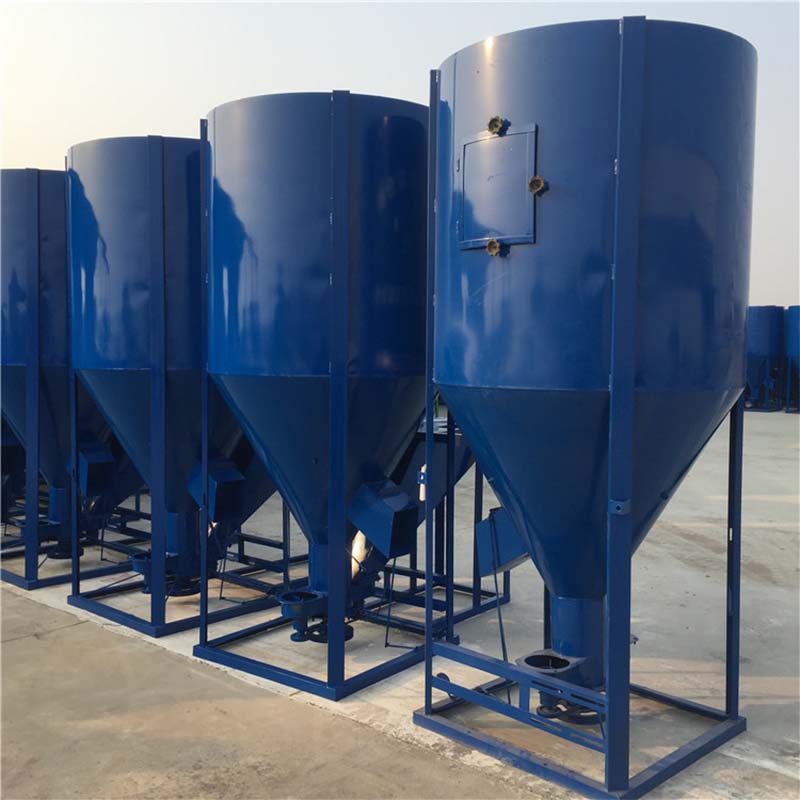
Diverse Application Scenarios
The versatility of a combined feed mixer and grinder system makes it indispensable across a spectrum of animal agriculture applications. Its ability to process various raw materials into a homogeneous feed mixture is critical for optimizing animal health and productivity.
- Commercial Poultry Farms: Producing broiler, layer, and breeder feed formulations from grains, protein meals, and vitamin/mineral premixes. The precise particle size control from the grinder ensures optimal digestibility for different age groups.
- Swine Operations: Customizing pig starter, grower, and finisher feeds. The efficient mixing capability ensures even distribution of medication or growth promoters, crucial for herd health.
- Cattle & Dairy Farms: Preparing balanced rations for beef cattle and dairy cows, including complex blends of silage, hay, grains, and supplements. The mixer's thorough action prevents ingredient separation, a common issue with coarser materials.
- Aquaculture Feed Production: Formulating specialized diets for fish and shrimp, where very fine grinding and consistent mixing are often required for pellet stability and water quality management.
- Small to Medium-Sized Feed Mills: Serving as the core processing unit for local feed production, offering flexibility to produce various feed types for multiple clients.
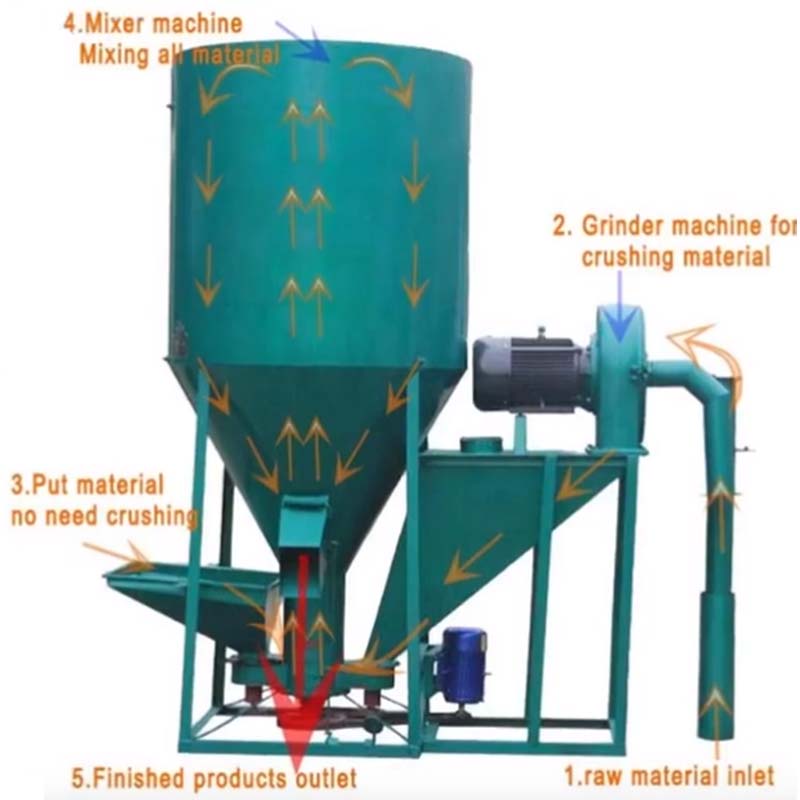
Technical Advantages of Advanced Feed Milling Systems
The design and engineering of modern vertical feed mixers for sale are driven by a commitment to enhancing operational efficiency and feed quality. Key technical advantages include:
- Homogeneous Mixing: The vertical auger design provides a gentle yet thorough mixing action, ensuring that even trace minerals and vitamins are evenly distributed throughout the batch. This prevents nutrient deficiencies and promotes uniform growth rates in animals.
- Optimized Grinding Efficiency: Integrated hammer mills feature precisely balanced rotors and high-strength hammers (often tungsten carbide-tipped for extended life), which efficiently reduce raw material particle size with minimal energy consumption. Screen changes are typically fast, allowing for quick adjustments to feed texture.
- Reduced Cross-Contamination: The enclosed nature of the vertical system, combined with efficient discharge mechanisms, minimizes residue between batches, which is critical for preventing cross-contamination, especially when processing medicated or specialty feeds.
- Low Maintenance & High Durability: Constructed from robust materials and featuring easily accessible wear parts (hammers, screens, auger bearings), these systems are designed for minimal downtime and extended operational life. Predictive maintenance features, such as vibration monitoring, can be integrated.
- Energy Economy: Advanced motor controls, such as Variable Frequency Drives (VFDs), optimize power usage based on load, leading to significant energy savings and reduced operating costs over the lifespan of the equipment.
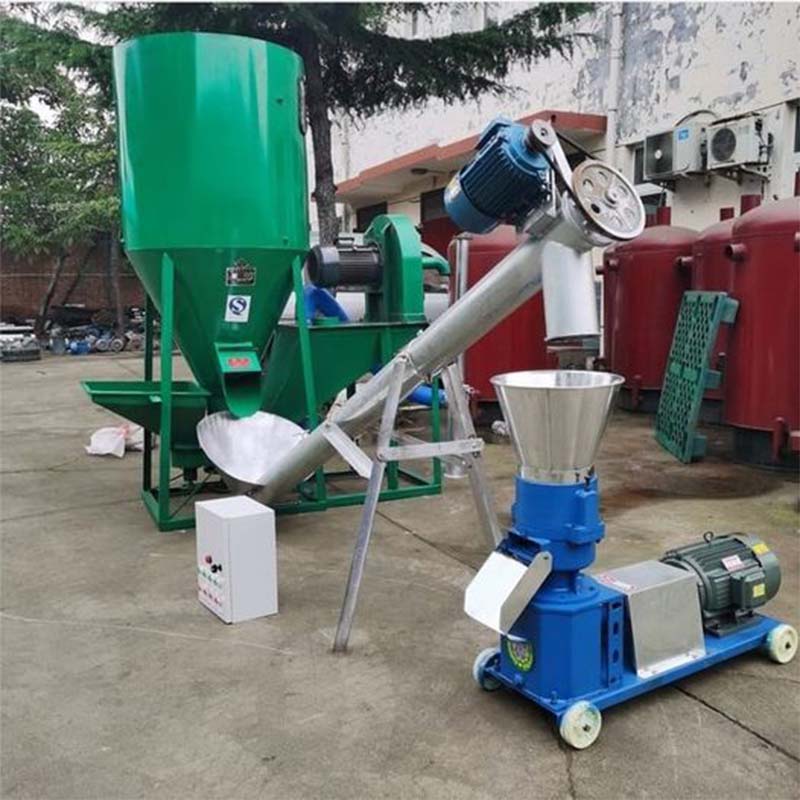
Vendor Comparison: Selecting Your Feed Miller with Mixer
Choosing the right vendor for your feed miller with mixer is a strategic decision that impacts long-term operational success. Beyond initial cost, factors such as build quality, technological integration, after-sales support, and customization capabilities are paramount. The table below provides a comparative overview of key criteria to consider.
| Feature/Criterion | Vendor A (Premium) | Vendor B (Mid-Range) | Vendor C (Budget) |
|---|---|---|---|
| Build Quality & Materials | High-grade SS304/Q345, precision CNC, robot welding, extensive wear parts. ISO/CE/FDA certified. | Q235/Q345 with critical parts SS, good welding, standard wear parts. CE certified. | Standard carbon steel, basic welding, limited wear parts options. No specific certifications mentioned. |
| Mixing Uniformity (CV) | ≤ 3% (Exceptional) | ≤ 5% (Very Good) | ≤ 7% (Acceptable for basic feed) |
| Automation & Control | Advanced PLC with HMI, remote monitoring, recipe management. | Basic PLC or manual controls, optional HMI. | Manual push-button control only. |
| Energy Efficiency | High-efficiency motors, VFDs standard, optimized grinding profiles. | Standard efficiency motors, optional VFD. | Standard efficiency motors, no VFD. |
| After-Sales Support | 24/7 technical support, global service network, spare parts readily available. | Business hours support, regional service, common spare parts. | Limited online support, local parts sourcing required. |
| Warranty | 24 months on main components, 12 months on wear parts. | 12-18 months on main components, 6 months on wear parts. | 6-12 months on main components, limited wear parts. |
| Customization Options | Extensive (material, capacity, control, auxiliary equipment integration). | Moderate (capacity, some material upgrades). | Minimal (standard models only). |
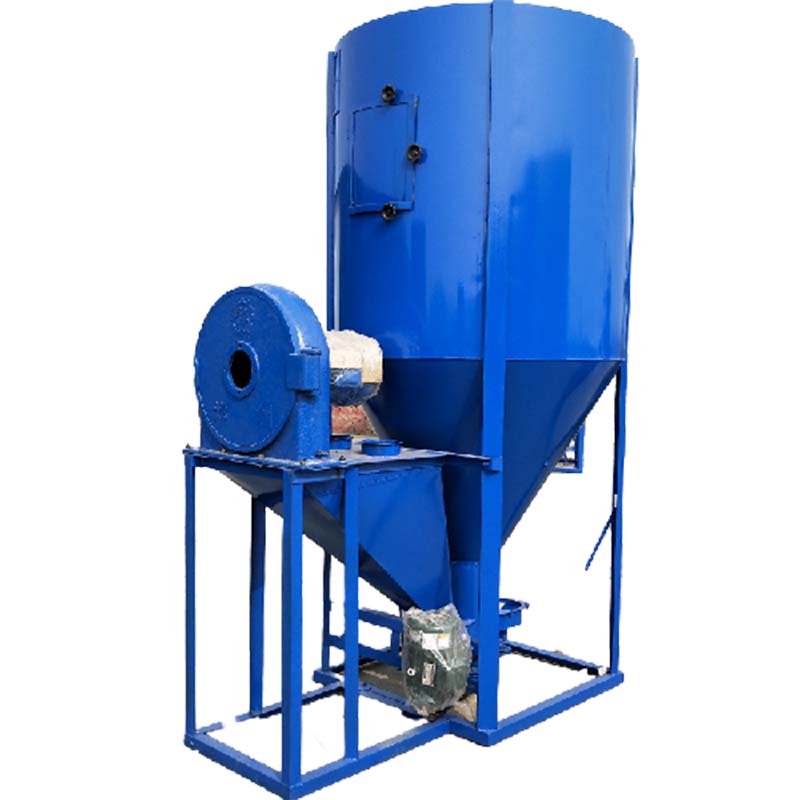
Customized Solutions for Diverse Operational Needs
Recognizing that every feed production facility has unique requirements, leading manufacturers offer highly customized solutions for their animal feed mixer systems. This flexibility ensures that the equipment seamlessly integrates into existing operations and meets specific production goals.
- Capacity Scaling: From compact units for small farms to larger systems for commercial feed mills, manufacturers can design and build mixers with grinding capabilities ranging from hundreds to several thousands of kilograms per batch.
- Material Adaptation: Options for stainless steel contact parts (SS304/316L) are available for handling corrosive ingredients or for applications requiring stringent hygiene standards, such as pharmaceutical-grade animal supplements or specific aquaculture feeds.
- Automation Integration: Custom control panels with Programmable Logic Controllers (PLCs) and Human-Machine Interfaces (HMIs) can be developed to integrate with existing plant automation systems, offering precise batching, mixing time control, and recipe management.
- Auxiliary Equipment Integration: Tailored solutions often include the integration of pre-cleaners, magnetic separators, fat sprayers, liquid additive pumps, and conveying systems to create a complete, streamlined feed production line.
- Site-Specific Design: Engineers can adapt machine dimensions, discharge heights, and inlet configurations to fit constrained facility layouts, optimizing space utilization and workflow.
Application Case Studies
Real-world applications demonstrate the tangible benefits of investing in a high-quality feed miller with mixer.
Case Study 1: Large-Scale Poultry Farm in Southeast Asia
A major poultry producer, managing over 500,000 birds, faced challenges with inconsistent feed quality and high energy costs using separate grinding and mixing units. After implementing a 2-ton/batch vertical animal feed mixer with grinder, they achieved:
- 20% reduction in energy consumption due to optimized motor usage and integrated process.
- Improved Feed Conversion Ratio (FCR) by 3%, attributed to superior mixing uniformity and consistent particle size, leading to better nutrient absorption.
- Reduced labor by one full-time equivalent (FTE) due to simplified operation and automation.
- Increased daily feed production capacity by 15% with shorter batch times.
Case Study 2: Niche Organic Pet Food Manufacturer in Europe
An organic pet food company required precise control over ingredient blending and particle size for sensitive, high-value formulations. They invested in a stainless steel (SS304) vertical feed mixer with grinder, integrated with a liquid addition system. The results included:
- Zero cross-contamination incidents, vital for maintaining organic certification and allergen control.
- Consistent product quality across batches, enhancing brand reputation and customer loyalty.
- Ability to produce highly specialized small batches efficiently, opening new market segments.
- Compliance with stringent EU food safety regulations due to robust design and material choices.
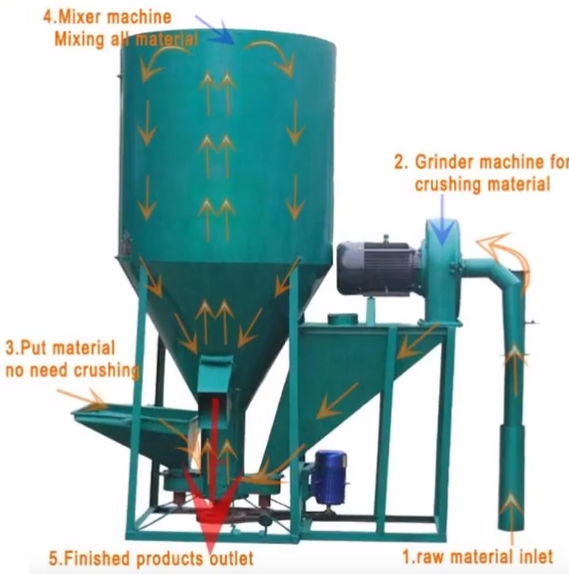
Frequently Asked Questions (FAQ)
Q1: What is the typical lifespan of a vertical animal feed mixer with grinder?
A1: With proper maintenance and operation, these machines are designed for a service life of 10-15 years, with wear parts requiring periodic replacement.
Q2: How does a vertical mixer achieve high mixing uniformity?
A2: The vertical design employs one or more large augers that lift material from the bottom of the mixing chamber to the top, allowing it to cascade down. This continuous circulation ensures thorough blending, often achieving a Coefficient of Variation (CV) below 5% for ingredient distribution.
Q3: Can the grinding particle size be adjusted?
A3: Yes, the particle size is primarily controlled by the size of the screens used in the hammer mill. Swapping screens allows for easy adjustment to produce coarser or finer grinds as required for different animal feeds.
Q4: What kind of power supply is required?
A4: Most industrial feed miller with mixer units require a three-phase power supply (e.g., 380V/50Hz/3-phase or 480V/60Hz/3-phase), with specific voltage and frequency requirements varying by region and machine size.
Lead Time & Fulfillment
Standard configurations of our vertical animal feed mixer with grinder typically have a lead time of 4-6 weeks from order confirmation to shipment. Custom-engineered solutions, including specific material upgrades, automation integration, or unique capacity requirements, may extend the lead time to 8-12 weeks. We employ a rigorous production scheduling and quality control process to ensure timely fulfillment and adherence to agreed-upon delivery schedules. Detailed logistics and shipping options (FOB, CIF, DDP) are provided at the quotation stage.
Warranty Commitments
We stand behind the quality and performance of our vertical feed mixers with a comprehensive warranty program. All main structural components and motors are covered by a 12-24 month warranty against manufacturing defects, depending on the specific model and agreement. Wear parts, such as hammers and screens, typically carry a 3-6 month warranty. Our commitment includes replacement or repair of defective components and dedicated technical support to address any operational issues during the warranty period. Extended warranty options are also available for enhanced peace of mind.
Comprehensive Customer Support
Our dedication to customer success extends beyond product delivery. We provide comprehensive after-sales support designed to maximize equipment uptime and operational efficiency.
- Technical Assistance: Our team of experienced engineers offers prompt technical support via phone, email, or video conferencing to troubleshoot issues and provide operational guidance.
- Spare Parts Availability: We maintain a robust inventory of genuine spare parts to ensure quick replacements, minimizing downtime for our clients.
- Installation & Training: On-site installation supervision and operational training can be arranged to ensure your team is proficient in operating and maintaining the equipment safely and efficiently.
- Maintenance Programs: We offer tailored preventive maintenance programs to prolong equipment life and optimize performance, including scheduled inspections and service.
References
- Food and Agriculture Organization of the United Nations (FAO). "The Future of Food and Agriculture – Trends and Challenges."
- ISO (International Organization for Standardization). "ISO 9001: Quality management systems – Requirements."
- Alltech. "Alltech Global Feed Survey." Annual reports on global feed tonnage and trends.
- American Society of Mechanical Engineers (ASME). "ASME Boiler and Pressure Vessel Code." (Relevant for material specifications and design standards).
- Journal of Animal Science. Peer-reviewed articles on feed processing efficiency and animal nutrition.
-
Efficient & Sustainable Chick Brooding Cage Systems for Modern Poultry Farming
NewsNov.24,2025
-
Cage for Chick: Optimizing Poultry Care for Global Food Security
NewsNov.23,2025
-
Baby Chicks Cage – Global Solutions for Sustainable Poultry Farming
NewsNov.22,2025
-
Baby Chick Cage: The Essential Guide to Brooding Solutions for Poultry Farmers
NewsNov.22,2025
-
Understanding Square Grain Silos: Global Impact, Benefits, and Trends
NewsNov.21,2025
-
Automatic Feeding Line System-Anping County Yize Metal Products Co., Ltd.|Automated Feeding&Watering
NewsNov.21,2025






